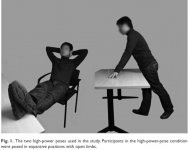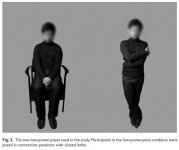Power Sitting
by Sally Augustin, PhD, People, Places, and Things blog
November 2010
Dr. Augustin is the author of Place Advantage: Applied Psychology for Interior Architecture.
Different seating postures literally make you feel more powerful - as well as more comfortable moving ahead in risky endeavors. Thank Carney, Cuddy, and Yap (see reference below) for figuring all of this out.
The key to power sitting is being in an open body posture and spreading out a little - imagine leaning back and putting your feet up on your desk. In that sort of high-power position your body increases the amount of testosterone coursing through your veins while decreasing the amount of cortisol found there. That's when the feeling powerful and taking risks begins.
In a closed posture, when people seem to sit drawn into as small and protected a position as possible, the opposite effect ensues.
The implications of this study for place design are direct. Spaces that allow power posturing, for example, by providing chairs that recline and allow people to extend their legs and simultaneously lean back with their hands behind their heads, will increase tolerance for risk and feelings of powerfulness. Hold a meeting in the lounge with those Eames recliners if you dare!
Reference:
Dana Carney, Amy Cuddy, and Andy Yap. "Power Posing: Brief Nonverbal Displays Affect Neuroendocrine Levels and Risk Tolerance." Psychological Science.
More info:
by Sally Augustin, PhD, People, Places, and Things blog
November 2010
Dr. Augustin is the author of Place Advantage: Applied Psychology for Interior Architecture.
Different seating postures literally make you feel more powerful - as well as more comfortable moving ahead in risky endeavors. Thank Carney, Cuddy, and Yap (see reference below) for figuring all of this out.
The key to power sitting is being in an open body posture and spreading out a little - imagine leaning back and putting your feet up on your desk. In that sort of high-power position your body increases the amount of testosterone coursing through your veins while decreasing the amount of cortisol found there. That's when the feeling powerful and taking risks begins.
In a closed posture, when people seem to sit drawn into as small and protected a position as possible, the opposite effect ensues.
The implications of this study for place design are direct. Spaces that allow power posturing, for example, by providing chairs that recline and allow people to extend their legs and simultaneously lean back with their hands behind their heads, will increase tolerance for risk and feelings of powerfulness. Hold a meeting in the lounge with those Eames recliners if you dare!
Reference:
Dana Carney, Amy Cuddy, and Andy Yap. "Power Posing: Brief Nonverbal Displays Affect Neuroendocrine Levels and Risk Tolerance." Psychological Science.

More info:
"We used to think that emotion ended on the face," Cuddy says. "Now there is established research showing that while it's true that facial expressions reflect how you feel, you can also 'fake it until you make it.' In other words, you can smile long enough that it makes you feel happy. This work extends that finding on facial feedback, which is decades old, by focusing on postures and measuring neuroendocrine levels."
Power Posing: Fake It Until You Make It - Harvard Business School
By this logic, smiling can make you happier. Raising your chest can make you feel more confident. Exercise can make you feel more capable, alive, vital and healthy. Perhaps it can even convince your brain that things aren’t quite so bad in the body, and that less pain is necessary. As my wife the psychotherapist might say, sometimes the best plan is to “fake it till you make it.”
Posture & Mood: A Two Way Street


